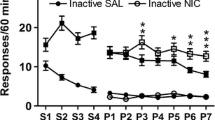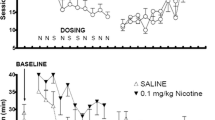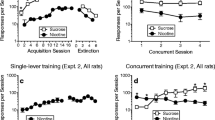Abstract
Rationale
Nicotine has two effects on reinforcement in traditional self-administration paradigms. It serves as a primary reinforcer by increasing the probability of behaviors that result in nicotine delivery. However, nicotine also potently enhances behaviors that result in the delivery of nonpharmacological reinforcers.
Objectives
The present study sought to dissociate these two effects of nicotine on reinforcement.
Methods
For one group of rats (2 lever), a nonpharmacological reinforcer [visual stimulus (VS)] was available for pressing one lever. Nicotine infusions were available for pressing a different lever. A second group (NIC + VS) received more traditional self-administration training; both the VS and nicotine were delivered for pressing a single active lever. Control groups received either nicotine infusions (NIC only) or VS presentations (VS only) for pressing the active lever.
Results
Nicotine alone was a weak reinforcer; the VS alone was slightly more reinforcing than nicotine. When these two reinforcers were combined (NIC + VS), response rates were synergistically increased. For the 2-lever group, responding on the nicotine lever was weak, matching the response rates of rats receiving nicotine alone. However, responding on the VS lever was potently enhanced in this group; equaling the response rates for rats receiving both reinforcers for making a single response (NIC + VS).
Conclusions
These data indicate that the reinforcement-enhancing effects of nicotine are very potent even when only moderate quantities of the drug are self-administered. Moreover, they provide the first demonstration that the reinforcement-enhancing and primary reinforcing effects of nicotine can be dissociated behaviorally.



Similar content being viewed by others
References
Andreoli M, Tessari M, Pilla M, Valerio E, Hagan JJ, Heidbreder CA (2004) Selective antagonism at dopamine D3 receptors prevents nicotine-triggered relapse to nicotine-seeking behavior. Neuropsychopharmacology 28:1272–1280
Caggiula AR, Donny EC, White AR, Chaudhri N, Booth S, Gharib MA, Hoffman A, Perkins KA, Sved AF (2001) Cue dependency of nicotine self-administration and smoking. Pharmacol Biochem Behav 70:515–530
Caggiula AR, Donny EC, White AR, Chaudhri N, Booth S, Gharib MA, Hoffman A, Perkins KA, Sved AF (2002) Environmental stimuli promote the acquisition of nicotine self-administration in rats. Psychopharmacology 163:230–237
Campbell UC, Carroll ME (2000) Acquisition of drug self-administration: environmental and pharmacological interventions. Exp Clin Psychopharmacol 8:312–325
Chaudhri N, Caggiula AR, Donny EC, Booth S, Gharib MA, Craven LA, Shannon SA, Sved AF, Perkins KA (2005a) Sex differences in the contribution of nicotine and nonpharmacological stimuli to nicotine self-administration in rats. Psychopharmacology 180:258–266
Chaudhri N, Caggiula AR, Donny EC, Palmatier MI, Xiu L, Sved AF (2005b) Complex interactions between nicotine and nonpharmacological stimuli reveal multiple roles for nicotine in reinforcement. Psychopharmacology (in press)
Chiamulera C, Rezzaghi F, Ardizzon M, Motta C, Marcon C, Tessari MA (1998) A novel model to study relapse to nicotine-seeking behaviour in rats. Arch Pharmacol 358:R578
Cohen C, Perrault G, Griebel G, Soubrié P (2005) Nicotine-associated cues maintain nicotine-seeking behavior in rats several weeks after nicotine withdrawal: reversal by the cannabinoid (CB1) receptor antagonist, rimonabant (SR141716). Neuropsychopharmacology 30:145–155
Corrigall WA, Coen KM (1994) Nicotine self-administration and locomotor activity are not modified by the 5-HT3 antagonists ICS 205-930 and MDL 72222. Pharmacol Biochem Behav 49:67–71
De Wit H, Stewart J (1981) Reinstatement of cocaine-reinforced responding in the rat. Psychopharmacology 75:134–143
Donny EC, Caggiula AR, Knopf S, Brown C (1995) Nicotine self-administration in rats. Psychopharmacology 122:390–394
Donny EC, Caggiula AR, Mielke MM, Jacobs KS, Rose C, Sved AF (1998) Acquisition of nicotine self-administration in rats: the effects of dose, feeding schedule, and drug contingency. Psychopharmacology 136:83–90
Donny EC, Chaudhri N, Caggiula AR, Evans-Martin FF, Booth S, Gharib MA, Clements LA, Sved AF (2003) Operant responding for a visual reinforcer in rats is enhanced by noncontingent nicotine: implications for nicotine self-administration and reinforcement. Psychopharmacology 169:68–76
Goldberg SR, Spealman RD, Goldberg DM (1981) Persistent behavior at high rates maintained by intravenous self-administration of nicotine. Science 214:573–575
Harvey DM, Yasar S, Heishman SJ, Panlilio LV, Henningfield JE, Goldberg SR (2004) Nicotine serves as an effective reinforcer of intravenous drug-taking behavior in human cigarette smokers. Psychopharmacology 175:134–142
Herrnstein RJ (1961) Relative and absolute strength of response as a function of frequency of reinforcement. J Exp Anal Behav 4:267–272
Le Sage MG, Burroughs D, Dufek M, Keyler DE, Pentel PR (2004) Reinstatement of nicotine self-administration in rats by presentation of nicotine-paired stimuli, but not nicotine priming. Pharmacol Biochem Behav 79:507–513
Le Foll B, Goldberg SR (2005) Control of the reinforcing effects of nicotine by associated environmental stimuli in animals and humans. Trends Pharmacol Sci 26:287–293
Lynch WJ, Carroll ME (1999) Regulation of intravenously self-administered nicotine in rats. Exp Clin Psychopharmacol 7:198–207
Niaura R, Shadel WG, Abrams DB, Monti PM, Rohsenow DJ, Sirota A (1998) Individual differences in cue reactivity among smokers trying to quit: effects of gender and cue type. Addict Behav 23:209–224
Paronis CA, Gasior M, Bergman J (2002) Effects of cocaine under concurrent fixed ratio schedules of food and IV drug availability: a novel choice procedure in monkeys. Psychopharmacology 163:283–291
Perkins KA, Epstein LH, Grobe J, Fonte C (1994) Tobacco abstinence, smoking cues, and the reinforcing value of smoking. Pharmacol Biochem Behav 47:107–112
Rescorla RA (1967) Pavlovian conditioning and its proper control procedures. Psychol Rev 74:71–80
Rose JE, Behm FM, Westman EC, Johnson M (2000) Dissociating nicotine and nonnicotine components of cigarette smoking. Pharmacol Biochem Behav 67:71–81
Shaham Y, Adamson LK, Grocki S, Corrigall WA (1997) Reinstatement and spontaneous recovery of nicotine seeking in rats. Psychopharmacology 130:396–403
Tessari M, Pilla M, Andreoli M, Hutcheson DM, Heidbreder CA (2004) Antagonism at metabotropic glutamate 5 receptors inhibits nicotine- and cocaine-taking behaviours and prevents nicotine-triggered relapse to nicotine-seeking. Eur J Pharmacol 499:121–133
US Department of Health and Human Services (USDHHS) (1988) Nicotine addiction: a report of the surgeon general. US Department of Health and Human Services. Office of the Assistant Secretary for Health, Office on Smoking and Health, Rockville, MD
Woolverton WL (1996) Intravenous self-administration of cocaine under concurrent VI schedules of reinforcement. Psychopharmacology 127:195–203
Woolverton WL, Alling K (1999) Choice under concurrent VI schedules: comparison of behavior maintained by cocaine or food. Psychopharmacology 141:47–56
Acknowledgements
The authors would like to thank Dr. Neil Levens for his thoughtful comments on a previous version of this manuscript. All experiments followed the “Principles of laboratory animal care” (NIH #85-23, revised 1985) and were approved by the University of Pittsburgh Institutional Animal Care and Use Committee (assurance #A3187-01). This research was supported by NIH grants DA-10464, DA-12655, and DA-19278.
Author information
Authors and Affiliations
Corresponding author
Rights and permissions
About this article
Cite this article
Palmatier, M.I., Evans-Martin, F.F., Hoffman, A. et al. Dissociating the primary reinforcing and reinforcement-enhancing effects of nicotine using a rat self-administration paradigm with concurrently available drug and environmental reinforcers. Psychopharmacology 184, 391–400 (2006). https://doi.org/10.1007/s00213-005-0183-4
Received:
Accepted:
Published:
Issue Date:
DOI: https://doi.org/10.1007/s00213-005-0183-4




